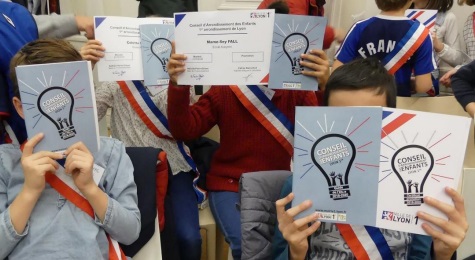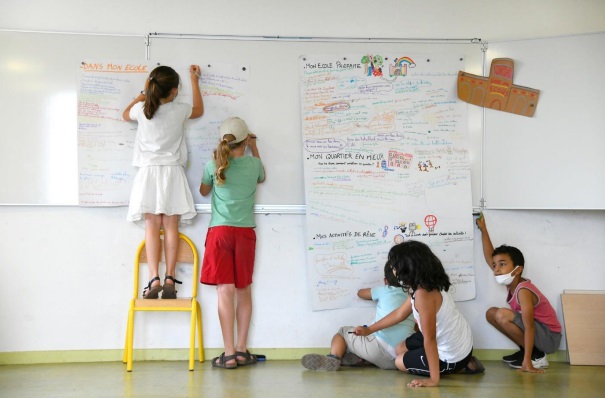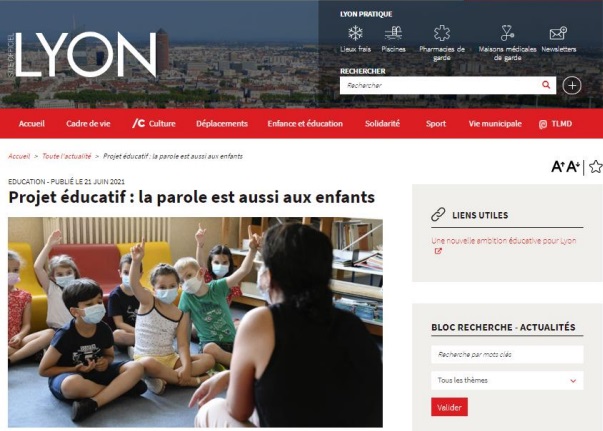France
Ville de Lyon
Since 2021
 16th.
16th.
The aim is to make children full players in their city, by promoting their rights, guaranteeing them a real place in a space that is still too often ill-suited to their needs, and developing their power to act.
The overhaul of this strategic and operational framework, the "territorial educational project", was the first of its kind in Lyon, and led to the development of children's participation both quantitatively (offering different spaces for dialogue to reach more children) and qualitatively (proposing different ways of participating, and encouraging the power to act).
The aim is also to develop a shared culture of participation for this specific audience within the city's departments.
700 children were consulted by 23 structures to draw up the territorial educational project, and 128 children were elected to the children's borough council in 27 schools in 4 boroughs (not counting the work carried out by elected representatives to reach out to their fellow pupils). 600 primary school children have taken part in "rue des enfants", and 600 children have taken part in greening workshops for over a year.
The City of Lyon (France) promotes a city that is child-friendly, considering that a city for children is also a city for everyone, and that it improves the quality of life for all. This ambition has led it to develop children's participation in a quantitative (offering different spaces for dialogue to reach more children) and qualitative way (offering different ways of participating and encouraging the power to act), according to 3 complementary axes:
1- to work with children on developments and policies that affect them : it is a question of doing with them and not only for them, by associating them:

2- to develop education for citizenship, commitment and emancipation through its territorial educational project : It is a question here of encouraging commitment to the service of the group, with the implementation of :
3- give them a voice in the construction of public policies by developing specific participation tools for them (drawings, sensitive notebook for children on the redevelopment of a garden, paper cocottes for the participatory budget...), building little by little a "toolbox" adapted to this public.

Inclusion
The "children" audience is one that is seldom heard in traditional consultations. Seeking out their voice, listening to them, is important, and also makes sense, as future generations, for all participants.
700 children were thus consulted by 23 structures (associations of popular education and associative and municipal leisure centers) to draw up the territorial educational project.
For the CAEs, 128 children were elected in 27 schools in 4 arrondissements (not counting the work carried out by elected representatives to reach out to their fellow pupils). Eventually, there should be CAEs in every arrondissement, and a children's municipal council.
600 primary school children took part in a consultation or artistic intervention as part of the "children's streets" projects.
600 children from 11 different schools took part in consultation workshops on greening their school grounds between January 2021 and February 2022.
Impact and results
The children's consultations were taken into account in the drafting of the educational project and included in the assessment, as well as for the landscaping around the schools. In the case of the Chartreux Gardens, they were used to finalize the diagnosis and draw up the program guidelines for the park's rehabilitation.
Most of the "children get organized" initiatives are still underway, as are the children's borough councils. A first "victory" was celebrated for the Veyet school, with a return to class at 2:05 p.m. (10 minutes earlier than before, to take advantage of a calm period before the start of class. This request was made jointly with the Gones council.
Internally, a capitalization project is underway, with the aim of creating a toolbox on children's participation based on the experiments carried out, and thus contributing to the transformation of practices.
The fact that elected representatives not only give a voice to children, by creating suitable spaces, places and tools, but also adopt a listening posture contributes to the sincerity of the measures implemented, and to the transformation of public action.

This integrated and transversal participation approach, multiplying the spaces and formats, makes it possible to recognize children as full-fledged actors of the city. It is no longer a question of doing things for them, but rather of doing things with them, betting on the fact that this will allow for a more inclusive city, but also that an experience of democracy, whatever it may be, is transformative for children, the bearers of tomorrow's society.
This approach innovates by "systematizing" this target public in the City's participation processes and, more broadly, in its public policies: it thus develops a culture of participation within the City's departments, through flexible and capitalizable experiments, consistent with each other.
A very interesting initiative involving children in the production of the territorial educational plan. Although considerable resources were devoted to this experiment, its effects and evaluation seem limited.